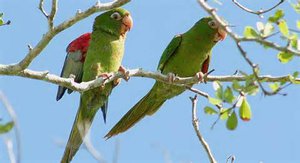Advertisement
Published: October 23rd 2014

 Cuban Parakeet
Cuban Parakeet
(Photo source: Wikipedia)Travel Notebook Learning Adventure
Photography: capture the essence of people and place
Writing: transform experience into story
(and have fun too)
A chance of a lifetime!
Introducing Baracoa Safari: Into the Biosphere (February 27-March 8, 2015) Experience a unique learning adventure with writer Kate MacDonald and photographer and adventure leader James Archbold. We will travel into Alexander von Humboldt National Park, along the Rio Toa and its tributaries to the 305-metre Salto Fino cascade, the highest waterfall in the Caribbean, enjoy the spectacular scenery, and meet the friendly people of the Baracoa region.
Baracoa Safari will take us into the unique biosphere of Humboldt, a UNESCO World Heritage Site. As one of the world’s last untouched rainforests, Humboldt boasts a large number of species unique to Cuba and the region, as well as endangered plant, bird, and animal species. Think of an untouched Galapagos!
You will be one of the few to experience this exciting trip into a unique biosphere. According to the UNESCO website, “The park has a flora list of 1,302 spermatophytes (plants that produce seeds) and 145 species of pteridophytes (plants that reproduce by spores such as

 Baracoa Flower
Baracoa Flower
Walking in the low-level forest, I came across a cluster of these small white flowers in a mix of small stones and crushed coral. (Photo by Kathryn MacDonald©)ferns), of which 905 species are endemic to Cuba, representing almost 30%!o(MISSING)f all endemics reported for the country. Of this total figure, 343 species live exclusively in this area. The local flora includes five species of carnivore plant, one of which is
Pinguicola lignicola, the only Cuban epiphyte (plants such as mosses, that grows non-parasitically on another plant). There are also two endemic species of the genera
Podocarpus and
Dracaena. According to recent collections, five new species to science have been made in the region, one of which is a pine. A species of the genus
Buxus (reported as extinct) was found in the area too. At least 30%!o(MISSING)f the mammals, 21%!o(MISSING)f the birds, 83.3%!o(MISSING)f the reptiles, 95.8%!o(MISSING)f the amphibians and 27.7%!o(MISSING)f the insects are local or national endemisms (which means unique to the island). The area is of particular importance for several species are of particular conservation concern…. Forests in the region are important as refuge for many resident and migratory bird species, such as the Cuban Amazon parrot and Cuban parakeet. With regard to reptiles, three new species of Anolis lizard have been recently collected from the park.”
After meeting and

 Fernandina's Flicker
Fernandina's Flicker
(Photo source: Wikipedia)getting to know each other in Baracoa on Friday night, workshop participants will wake Saturday morning to travel by jeep and/or other appropriate vehicles, while pack horses will carry our supplies into isolated areas. We’ll head in a northwesterly direction, climbing into the Macizo Nipe Sagua Baracoa/Nipe Sagua Baracoa Massif, which includes the second highest peak in Cuba. Although we will visit a small section of the 70,000 hectare park, it will be an amazing personal revelation for each of us.
This workshop requires a fitness rating of about 7/10 or moderate, involving some hiking and some overnight camping, but expedition is not onerous. Our pace will be leisurely, allowing plenty of time to take field notes as research for articles, write postcard-length stories, take photographs, and develop our skills while learning about this unique biosphere. Local and expert guides will assist us in identifying species. Don’t miss this once in a lifetime opportunity.
For more information, please go to
www.travelnotebook.ca and back to the blog in a few days for profiles of workshop sites.
Advertisement
Tot: 0.113s; Tpl: 0.009s; cc: 8; qc: 48; dbt: 0.0666s; 1; m:domysql w:travelblog (10.17.0.13); sld: 1;
; mem: 1.1mb

 Cuban Parakeet
Cuban Parakeet
 Baracoa Flower
Baracoa Flower
 Fernandina's Flicker
Fernandina's Flicker
Justine Inman
non-member comment
Hooded Warbler
This photo of the so said "Bachman's Warbler" is actually not what you say it is. This is actually a Hooded Warbler. People confuse them because they look very similar but in fact it is not a Bachman's. You can tell the difference because the Bachman's doesn't have a black hood-like shape around it's head, as this one does, like a Hooded.